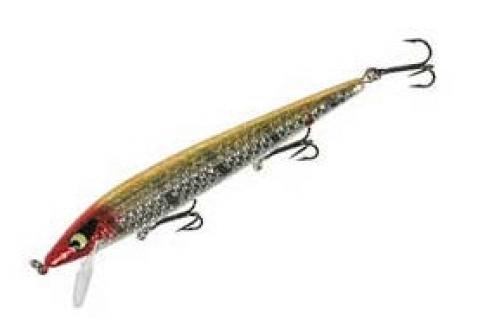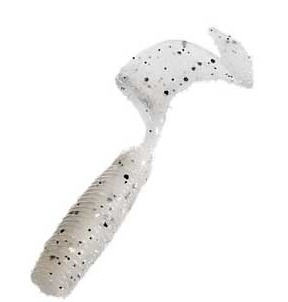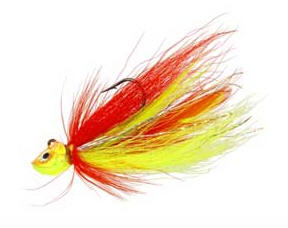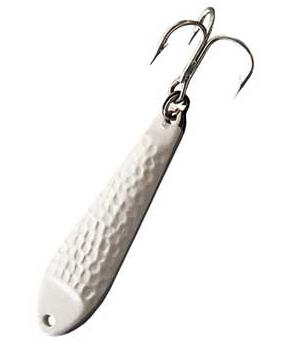
Bass, as you probably know, are cold-blooded creatures, meaning their body temperature is the same as that of their surroundings. As the water temperature drops, so does their metabolic level. The digestive process is greatly slowed; according to Doug Hannon, ESPN's Bass Professor, it takes a bass about four hours to digest a meal in 80-degree water, four days in 50-degree water! As the water temperature plummets, the need for frequent feeding diminishes, and bass become less active. But then, if you've ever gone strikeless at a bass club tournament on a frigid winter or early spring day, you already knew that!
Bass pros and guides are on the water constantly, and must use creative methods for catching bass when the lake is frigid. Choosing the right lure is a huge part of this equation. If you've had trouble scoring strikes when the water temp drops below 50 degrees, study what follows carefully. Some of bass fishing's top pros and guides are about to heat up your next bass outing.
Suspending Jerkbaits to Catch Bass
Seasoned bass pros like Larry Nixon swear by these minnow mimics in water as cold as 40 degrees. They work best in clear to moderately stained lakes.
 |
| Smithwick's Suspending Rogues suspend perfectly right out of the box — no drilling and filling necessary. |
"Suspending jerkbaits, unlike most other bass lures, draw strikes when they're sitting still," Nixon told BASS PRO ONLINE. "In fact, that's when most of your hits will come on this bait — when it's hanging absolutely motionless in the water column."
Nixon was the first bass pro to realize the power of suspending jerkbaits for catching early-spring bass. "I used to drill holes in floater/diver minnows like the Rebel Spoonbill, then fill 'em with lead shot to get 'em to suspend, a time-consuming trial-and-error process if ever there was one," he confessed. "Now most lure companies offer minnow baits weighted at the factory to suspend perfectly. No more drilling and filling — a lure like a Smithwick Suspending Rogue will suspend perfectly right out of the box."
Suspending jerkbaits match the lethargic mood of cold-water bass, the pro said. "In early spring, bass in clear lakes often suspend off points, flats and other potential spawning areas, waiting for the water to warm before moving shallow. These fish won't move far to grab a meal, but they're suckers for a jerkbait fished at their level." When fishing these baits, remember that less is more, Nixon added. "Most anglers fish 'em way too hard and fast. Cast, reel the lure down to its maximum depth, give one or two quick snaps of the rod tip, then just let it sit motionless -- the colder the water, the longer you should pause between jerks."
Nixon's bonus tip: "Fish a suspending jerkbait on a long, light-action crankbait rod, one with plenty of give. Many bass will be foul-hooked on this lure, and the hooks may rip out when a stiff-action rod is used. Fairly light line, 10 to 12 pound, will handle a big fish in open water while allowing the lure to get down to its maximum depth."
Jig 'n Pig Bass Bait
When the lake is cold and stained-to-muddy, nothing works harder to connect you with a lunker bass than a jig 'n pig. This reliable bass bait has accounted for many monster largemouths in winter and early spring.
Bass pro Ron Shuffield is an admitted jig junkie. "When the water is below 50 degrees, I feel more confident fishing a jig 'n pig than any other lure," he testified. "When rigged with a split-tail pork frog, it's a near-perfect crawfish mimic. The heavy jighead bumps through submerged brushpiles and over logs with ease, and the jig's rubber skirt and tails of the trailer flare out like the arms and pinchers of a live craw. This is the ultimate cold-water big-bass lure. I caught a 10 1/2-pounder on a jig 'n pig at an Arkansas lake last January."
Shuffield targets submerged wood cover lining reservoir creek channels and ditches in the dead of winter. "This pattern holds true everywhere I've fished for bass. Just run up a tributary arm and work your way back out following the old creek channel, pitching a jig 'n pig to every stump, log and stickup you encounter. If you can find an underwater ditch, even better, because these subtle structures receive very little fishing pressure and can hold monster bass."
Ron fishes the jig 'n pig on a 7-foot heavy-action baitcasting rod or flipping stick with 20 pound mono fishing line: "Jig fishing is not an ultralight game; you've got to hammer the fish and winch it out of thick cover."
Shuffield's bonus tip: "When fishing a jig 'n pig in a laydown tree, you'll hang up less often by swimming the lure horizontally through the branches rather than letting it fall vertically through them. Hold your rod at 10 o'clock and reel steadily, speeding up slightly if you feel the jig drag the tree. A swimming jig looks just like a moving crawfish."
The Grub Bass Lure
 |
| Christian favors a 4- or 5-inch twist-tail grub rigged on a 1/4-ounce jighead for winter bass. |
"A grub is the deadliest bass lure you're not fishing!" joked legendary Tennessee bass angler and former Priest Lake guide Jack Christian. "It'll catch bass both shallow and deep, in clear to murky water, yet for some reason most bass anglers never use it. For cold water, it's a great choice -- compact to match the suppressed appetite of bass, and highly realistic in appearance, like a small shad. I've caught largemouths over 9 pounds, smallmouths over 7 on grubs."
For winter bass, Christian favors a 4- or 5-inch twist-tail grub rigged on a quarter-ounce jighead. He fishes it on a heavy-action 6-foot spinning rod with 8 pound mono. Sloping chunk-rock banks are his favorite targets: "Bass gravitate to banks with a 45-degree slope in winter because here, they can make a significant depth change without swimming a long distance and exerting a lot of energy. Position your boat so you're facing the bluff, cast the grub shallow, allow it to sink, then raise the rod tip sharply to 11 o'clock to snatch the lure off the rocks. Repeat this until the grub is directly under you. Bass will strike it as it's falling; if you see the line hop, set the hook."
Christian's bonus tip: "Color is extremely important when fishing grubs. Most anglers like chartreuse; I've found this color to be much better in spring, when the water is 58 degrees and above, than in winter. In clear lakes, try smoke glitter on sunny says, smoke pepper (black flakes) on cloudy days. If the water is stained, try pumpkin pepper."
Hair Jig Bass Lure
 |
| Depending on its color and where it's fished, hair jigs can mimic a crawfish or minnow. |
"The plain ol' hair jig, a.k.a. bucktail or fly, is my favorite winter/early-spring bass lure in river-run reservoirs," said Pickwick Lake, Alabama, bass guide Steve Hacker. "It's extremely compact, and looks like either a crawfish or minnow, depending on its color and where you fish it. It's a world-class smallmouth lure, but largemouths will eat it as well. Most important, it's the most basic of all fishing lures, one that'll catch anything that swims in gin-clear to muddy water. You can even fish it under a bobber for suspending bass."
Hacker, a smallmouth specialist, targets hard-bottom structures with hair jigs, including rockpiles, shell mounds, humps and channel breaks. "In water from 48 to 50 degrees, I'll fish 'em 9 to 14 feet deep, dropping down as deep as 28 feet when the water dips to 40 degrees. I like current and dingy water when fishing hair jigs."
The guide uses a "drop 'n pop" retrieve" "Cast the jig to the structure, let it drop to the bottom, then pop the rod tip so it shoots off the bottom. Bass usually take it on the fall."
Steve fishes 1/4 and 3/8 ounce bucktails most of the time, the latter in deeper water/increased current. "I start with a jig having white as its primary color, since shad are the predominant forage in the Tennessee River system. My second choice is black. Chartreuse is good, too, but gets pecked at a lot by white bass and drum." He fishes these lures on a stiff 6 1/2-foot spinning rod with 6 to 8 pound mono and a 6-9 medium-heavy baitcaster with 12 to 15 pound line, the latter in heavily-stained water.
Hacker's bonus tip: "You can fish a hair jig with or without a pork trailer. In slack water, a trailer adds a little more bulk to the bait so it falls slower. In current, I leave the trailer off so the lure slices through moving water more efficiently."
Blade Bait
 |
| McClintock uses a 1/2-ounce blade when he graphs bass or baitfish down to 30 feet and 3/4-ounce blade when fish are deeper. |
Like grubs, relatively few bass anglers fish blade baits. These thin slabs of metal drop into the strike zone like a rock, deliver vibrations frantic enough to jar your fillings loose, and flash like a strobe light to attract bass from their canyon-deep lairs in clear, cold lakes. They're highly versatile -- you can fish 'em like a drop bait, jig 'em vertically or reel 'em straight in like a crankbait.
Dale Hollow Lake, Tenn. guide Fred McClintock, a recent inductee into the National Fresh Water Fishing Hall of Fame, relies on blade baits to catch largemouths, smallmouths and spotted bass on the harshest winter days. "These are my bread-and-butter winter bass baits," he said. "I use a 1/2-ounce blade when I see bass or baitfish down to 30 feet on my graph; a 3/4-ounce when fish are deeper."
Fred's favorite way to fish a blade is by stairstepping it down rock ledges. "In highland reservoirs, bass hold on these short outcroppings in winter, often 50 feet or deeper. Position your boat in deep water, cast the blade to the bank, and let it fall with a slight bow in your line -- this is accomplished by slowly lowering your rod while the lure drops. When it hits bottom, stroke the rod upward; the blade will jump off the bottom, vibrating and flashing like a fleeing shad. Let it drop to the next ledge, again while lowering the rod slowly. If you feel a tap or see the line hop, a bass has inhaled the blade, so set the hook." The guide uses a 7-foot medium-action baitcasting rod and 10 to 14 pound mono for blade bait fishing.
McClintock's bonus tip: "Before reeling in a blade bait, always jig it up and down a few times when it's directly under the boat. Bass, sometimes an entire school of them, may follow the blade in without striking, and this erratic presentation often triggers a reaction strike."
Jigging Spoon
 |
| Spoons mimic injured or frightened minnows, and bass usually suck them in as they're falling. |
Another versatile metal lure, the jigging spoon is best fished vertically in deep, cold water. Tennessee guide Jim Duckworth uses it for largemouth, smallmouth and spotted bass in water as cold as 36 degrees. "It's my lure of last resort in midwinter," Duckworth told BASSIN'. " Last February I used it successfully at Center Hill, Dale Hollow and Priest lakes when it was so cold, I broke ice while launching my boat. I've caught spotted bass nearly 100 feet deep on spoons -- it's the all-time depth champion among bass lures."
Duckworth's favorite venue for deep spoonin' is a "hollow," a narrow tributary with a deep channel. "Hollows are V-shaped creek arms found on highland reservoirs," he explained. "Bass move into the middle of them to suspend when the water drops into the mid to low 40s, usually close to a big school of baitfish."
Jim idles his boat down the middle of a tributary, stopping when he spots a big ball of suspended shad on his graph. He then lowers the spoon straight down by pulling line off his reel, counting the distance until the lure is dangling at or just above the level of the bait. "Work the spoon up and down with short pops of the rod tip, varying the number and intensity of the pops until you determine what the bass want," he explaines. "The spoon mimics an injured or frightened minnow; bass usually suck it in as it's falling." He fishes spoons weighing 3/8 to 1 ounce, depending on the depth of the bass, using a 6-foot medium-heavy spinning rod with 10-pound braided line. "Braided line is a must for spoonin'; it lets you feel light strikes at extreme depths and doesn't get kinky like mono in super-cold water."
- 33444 views

